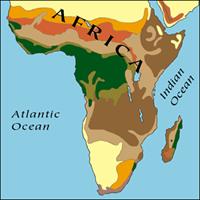Sub-Saharan Africa Spring 2008 Regional Economic Outlook: Growth Expected to Remain Robust but Global Developments Cloud Prospects

The immediate prospects are for continued economic expansion but with a widening gap between oil exporters and oil importers. Growth in sub-Saharan Africa should again average about 6½ percent this year, driven by oil exporters; growth in oil importers is expected to taper off modestly. With higher food and energy prices, inflation is projected to rise slightly to about 8½ percent this year.
Compared with the 1990s, the region is better placed to withstand a worsening of the global environment. Many countries in the region are less exposed to shifts in global economic conditions. Smaller current account and fiscal deficits, lower inflation, reduced debt, increased foreign reserves, and strengthened policy frameworks have all helped make the region more resilient to external shocks.
Nonetheless, the external environment has become less favorable, and risks in 2008 are tilted to the downside. The global economy is slowing down, oil prices have risen to record levels, and global financial markets are unsettled. This marks a shift from recent years when demand for sub-Saharan African exports was healthy, and nonfuel commodity prices were growing at double digits. Rising oil and food prices pose increasing challenges to many countries and risks to the inflation outlook. If high oil prices are accompanied by a pronounced slowdown in the global economy—bringing weaker non-oil commodity prices—the exports of sub-Saharan Africa would be affected.
Also, while African markets have so far shown limited reaction to continuing turbulence in global financial markets, a reversal of portfolio flows could reduce external financing and hurt growth in a few countries. In light of these risks, there is about a one-in-five chance in 2008 that growth in sub-Saharan Africa will fall to less than 5 percent.
Internal risks have also increased in some regions. Post-election violence in Kenya led to shortages and price hikes not only in Kenya but also in neighboring countries. Despite the recent political progress, uncertainty remains about the extent of growth slow down and the pace of recovery. The unrest in Chad also has implications for neighboring countries. Careful management of the political and security situation and appropriate policy responses can help sustain the current expansion.
The main medium-term challenge for sub-Saharan Africa is to accelerate growth and achieve the Millennium Development Goals (MDG). While a growing number of countries are enjoying robust growth, only a few sub-Saharan African countries seem well-positioned to halve poverty by 2015. Notwithstanding the improvement in economic growth since the mid-1990s, real per capita income is about the same as in the mid-1970s. Only with sustained per capita growth can extreme poverty rates for the whole of sub-Saharan Africa be expected to fall. In sum, while the recent improved economic performance in sub-Saharan Africa is encouraging, the region has a lot of catching up to do if it is to achieve the MDGs.
 Back and Next - Back and Next
Back and Next - Back and Next See Also - See Also
See Also - See Also